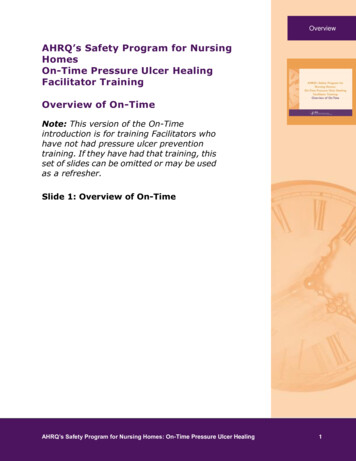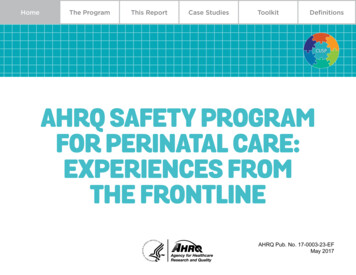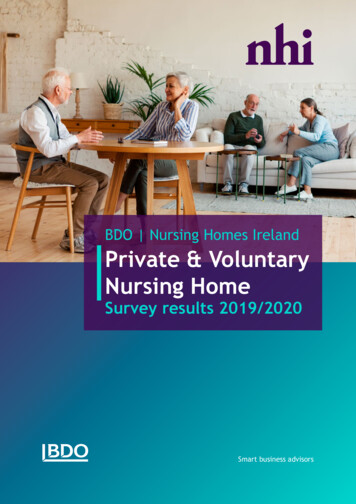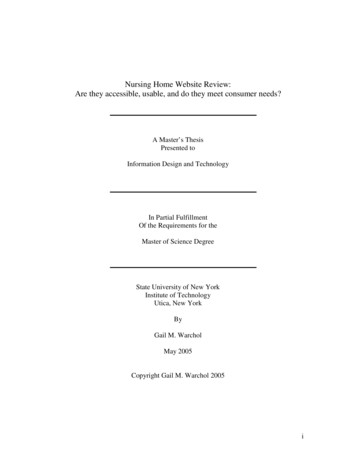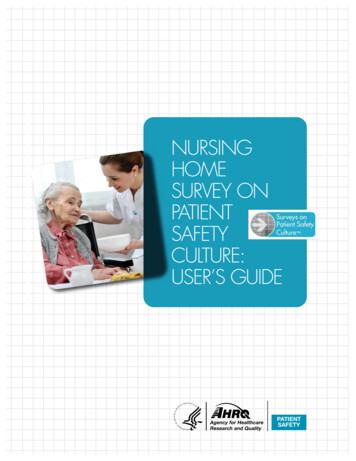
Transcription
NURSINGHOMESURVEY ONPATIENTSAFETYCULTURE:USER’S GUIDEPATIENTSAFETY
AHRQ Nursing Home Survey on Patient SafetyCulture: User’s GuidePrepared for:Agency for Healthcare Research and QualityU.S. Department of Health and Human Services5600 Fishers LaneRockville, MD 20857http://www.ahrq.govContract No. HHSP233201500026I/HHSP23337004TPrepared by:Westat, Rockville, MDJoann Sorra, Ph.D.Laura Gray, M.P.H.Theresa Famolaro, M.P.S., M.S.Naomi Yount, Ph.D.Jessica Kirchner, M.A.AHRQ Publication No. 22-0029Replaces 18-0038-EFApril 2022
This project was funded under Contract Number HHSP233201500026I/HHSP23337004T fromthe Agency for Healthcare Research and Quality (AHRQ), U.S. Department of Health and HumanServices. The authors are solely responsible for this document’s contents, findings, andconclusions, which do not necessarily represent the views of AHRQ. Readers should not interpretany statement in this product as an official position of AHRQ or of the U.S. Department of Healthand Human Services. None of the authors has any affiliation or financial involvement thatconflicts with the material presented in this product.Public Domain Notice. This document is in the public domain and may be used and reprintedwithout permission in the United States for noncommercial purposes, unless materials are clearlynoted as copyrighted in the document. No one may reproduce copyrighted materials without thepermission of the copyright holders. Users outside the United States must get permission fromAHRQ to reprint or translate this product. Anyone wanting to reproduce this product for salemust contact AHRQ for permission.Citation of the source is appreciated.Suggested Citation:Sorra J, Gray L, Famolaro T, et al. AHRQ Nursing Home Survey on Patient Safety Culture: User’sGuide. (Prepared by Westat, under Contract No. HHSA290201300003C). AHRQ Publication No.22-0029 (replaces 18-0038-EF). Rockville, MD: Agency for Healthcare Research and Quality;April 2022. .
Contents of This User’s GuideThis AHRQ Nursing Home Survey on Patient Safety Culture User’s Guide and other toolkitmaterials are available on the AHRQ website (www.ahrq.gov/sops/surveys/nursing-home).These materials are designed to provide nursing homes with basic knowledge about how toadminister the SOPS Nursing Home Survey, analyze the data, and report results.Table of ContentsChapterPageChapter 1. Introduction1Development of the Nursing Home Survey on Patient Safety Culture . 2Survey Items and Composite Measures . 3Survey Modifications . 4Chapter 2. Getting Started5Determine Available Resources and Project Scope . 5Decide on Your Data Collection Method . 5Decide Whether Your Survey Will Be Confidential or Anonymous . 5Decide Whether to Use an Outside Vendor. 6Plan Your Project Schedule . 6Form a Project Team . 8Establish a Point of Contact . 9Perform Additional Tasks for Multiple Nursing Homes . 9Establish a Timeline . 9Use Nursing Home Codes or Identifiers . 9Chapter 3. Selecting Your Survey Population10Decide Who Should Complete the Survey . 10Compile Your Provider and Staff List . 11Nursing Home Survey on Patient Safety Culture User’s Guideiii
Contents (continued)ChapterPageChapter 4. Administering a Web Survey12Design and Test the SOPS Web Survey . 12Publicize and Promote the Survey .13Administer the Survey. 14Send a Prenotification Email . 14Send a Survey Invitation Email . 14Send Weekly Reminder Emails . 16Disseminate Weekly Response Rates . 16Chapter 5. Administering Paper Surveys17Determine How to Distribute and Return Completed Surveys . 17Develop and Assemble Survey Materials . 17Using Envelopes for Paper Survey Packets . 18Publicize and Promote the Survey . 18Administer the Survey. 19Send a Prenotification Letter (Optional). 19Distribute First Paper Survey Packet . 19Distribute Second Paper Survey Packet . 21Disseminate Weekly Response Rates . 21Chapter 6. Analyzing the Data22Create and Clean Your Survey Data File . 22Code Response Options . 22Identify Problematic or Ineligible Surveys. 23Clean the Data . 23Calculate the Final Response Rate . 24Deidentify and Analyze Open-Ended Comments . 24Analyze the Data . 24Calculate Frequencies of Response . 25Calculate Item Percent Positive Scores . 26Calculate Composite Measure Percent Positive Scores . 27Submit to the SOPS Database . 27References28Nursing Home Survey on Patient Safety Culture User’s Guideiv
List of Figures1Definition of patient safety culture .12Task timeline for project planning for a single nursing home . 73Web survey recommended survey administration steps . 144Paper survey recommended survey administration steps . 19List of Tables1SOPS nursing home survey patient safety culture composite measures . 32Confidential versus anonymous surveys . 63SOPS web survey design features . 124Sample response option coding . 225How to calculate an item percent positive score for a positively wordeditem . 266How to calculate item percent positive scores for a negatively worded item . 267Example of how to calculate item and composite measure percent positivescores . 27AppendixesASample Data Collection Protocol for the Nursing Home Point of Contact:Web Survey . 29BSample Data Collection Protocol for the Nursing Home Point of Contact:Paper Survey . 30Nursing Home Survey on Patient Safety Culture User’s Guidev
1.IntroductionAs nursing homes continually strive to improve patient safety and quality, nursing homeleadership increasingly recognizes the importance of establishing a culture of patient safety.Patient safety culture refers to the beliefs, values, and norms shared by healthcare practitionersand staff throughout the organization that influence their actions and behaviors.Patient safety culture can be measured by determining what is important and what attitudes andbehaviors are rewarded, supported, expected, and accepted with regard to patient safety. It isimportant to broadly establish a culture of patient safety because it exists at multiple levels:within healthcare systems, nursing homes, and units (Figure 1).Figure 1.Definition of Patient Safety CultureNursing Home Survey on Patient Safety Culture User’s Guide1
Development of the Nursing Home Survey on Patient SafetyCultureThe Agency for Healthcare Research and Quality (AHRQ) sponsored the development of theSurveys on Patient Safety Culture (SOPS ) Nursing Home Survey. The survey is designedspecifically for nursing home staff and asks for their opinions about the culture of patient safety attheir nursing home. The survey can be used to: Raise staff awareness about patient safety, Assess the current status of patient safety culture, Identify strengths and areas for patient safety culture improvement, Examine trends in patient safety culture over time, Evaluate the cultural impact of patient safety initiatives and interventions, and Conduct comparisons within and across organizations.Under contract to AHRQ, a Westat survey design team conducted the following activities toidentify key composite measures of nursing home safety culture, relevant background questionsabout staff and nursing home characteristics, and appropriate terms and words to use in thesurvey: Reviewed the literature, including existing surveys, pertaining to resident safety, nursinghome medical errors and quality-related events, error reporting, safety climate and culture,and organizational climate and culture. Conducted background interviews with experts in the field of nursing home safety andadministration, as well as nursing home managers and quality improvement directors. Developed draft survey items to measure the identified key composite measures. Conducted cognitive interviews with administration, providers, and staff throughout thenursing home. Obtained input on the draft survey from additional nursing home researchers and long-termcare experts. Tested the draft survey in a pilot study with more than 5,000 staff working in 40 nursinghomes across the United States. Examined the reliability and factor structure of the patient safety culture compositemeasures. Based on these analyses, the final items and composite measures in the NursingHome Survey on Patient Safety Culture were determined to have sound psychometricproperties (Sorra, et. al., 2008).Nursing Home Survey on Patient Safety Culture User’s Guide2
Survey Items and Composite MeasuresThe SOPS Nursing Home Survey is intended to help nursing homes assess their patient safetyculture and emphasizes resident safety issues. The survey has a total of 51 survey items: Forty-two survey items grouped into 12 composite measures that are groupings of two ormore survey items that assess the same areas of resident safety culture (Table 1 describes thecomposite measures).Table 1.SOPS Nursing Home Survey Patient Safety Culture Composite MeasuresPatient safety culturecomposite measureCommunication OpennessDefinition: The extent to which Number of itemsStaff speak up about problems and their ideas and3suggestions are valued.Compliance With ProceduresStaff follow standard procedures to care for residents3and do not use shortcuts to get their work done faster.Feedback and Communication About Staff discuss ways to keep residents safe, tell someone if4Incidentsthey see something that might harm a resident, and talkabout ways to keep incidents from happening again.HandoffsStaff are told what they need to know before taking4care of a resident or when a resident’s care planchanges and have all the information they need whenresidents are transferred from the hospital.Management Support for ResidentNursing home management provides a work climate3Safetythat promotes resident safety and shows that residentsafety is a top priority.Nonpunitive Response to MistakesStaff are not blamed when a resident is harmed, are4treated fairly when they make mistakes, and feel safereporting their mistakes.Organizational LearningThere is a learning culture that facilitates making4changes to improve resident safety and evaluateschanges for effectiveness.Overall Perceptions of ResidentResidents are well cared for and safe.3SafetyStaffingThere are enough staff to handle the workload, meet4residents’ needs during shift changes, and keepresidents safe, because there is not much staff turnover.Supervisor Expectations and Actions Supervisors listen to staff ideas and suggestions about3Promoting Resident Safetyresident safety, praise staff who follow the rightprocedures, and pay attention to safety problems.TeamworkStaff treat each other with respect, support one4another, and feel like they are part of a team.Training and SkillsStaff get the training they need, have enough training3on how to handle difficult residents, and understand thetraining they get in the nursing home. Nine single-item measures:–One survey item asking respondents whether they would tell friends that this is a safenursing home for their family (also called “willingness to recommend”)Nursing Home Survey on Patient Safety Culture User’s Guide3
–One survey item asking respondents to provide an overall rating on resident safety fortheir nursing home–Seven survey items on respondent background characteristics (job title, tenure innursing home, hours worked per week, shift, paid by staffing agency, direct interactionwith residents, and nursing home unit)Most of the survey items use 5-point agreement scales (“Strongly disagree” to “Strongly agree”) orfrequency scales (“Never” to “Always”) and include a “Does not apply or Don’t know” responseoption. The survey has a section at the end for open-ended comments.Survey ModificationsWe recommend administering the survey in its entirety without modifications or deletions. If anychanges to the core survey are made (such as changing the wording of the items or responseoptions, changing the order of the items or response options, deleting one or more items), thesurvey is no longer considered a trademarked SOPS survey. In addition, any changes to the coresurvey may affect the reliability and validity of the survey, and the survey results will not becomparable with results from other nursing homes.The successful use of SOPS surveys depends on everyone administering the same items in thesame order.Changing Background ItemsThe survey ends with background questions. Your nursing home can modify the responses tothese questions. For example, your nursing home may want to modify the responses to the jobtitles or work areas so they better match the names or titles used within your nursing home.For instance, in some nursing homes, residents may live in “neighborhood” clusters orcommunities staffed by a permanent team of clinical and nonclinical workers. To captureinformation about where a respondent works, the specific name of each neighborhood cluster canbe added to the response options for the work area item in the background information section ofthe survey. This information will enable survey feedback results to be provided to each cluster orneighborhood.Keep in mind that if your nursing home plans to submit to the SOPS Nursing Home Database, youmust recode your modified staff positions, work areas, or other background question responseoptions so they crosswalk back to the original survey’s response options for these questions.Adding Supplemental or Custom ItemsIf your nursing home wants to add items to the survey, add these just before the backgrounditems (after Section E and before Background questions). Supplemental items should not beadded within the core SOPS survey (i.e., do not add questions within Sections A–E).If you would like SOPS technical assistance staff to review your web or paper survey before youadminister it to ensure that it is consistent with the trademarked SOPS surveys, emailSafetyCultureSurveys@westat.com.Nursing Home Survey on Patient Safety Culture User’s Guide4
2.Getting StartedBefore you begin, it is important to understand the tasks involved in collecting survey data anddecide who will manage the project. This chapter is designed to guide you through the planningand decision-making stages of your project.Determine Available Resources and Project ScopeTwo of the most important elements of an effective project are a clear budget to determine thescope of your data collection effort and a realistic schedule. Think about your available resources: What is your budget and what resources are available to conduct this project? Who within the nursing home or healthcare system is available to work on this project? When do you need to have the survey results completed and available? Do you have the technical capabilities to conduct this project in the nursing home, or do youneed to consider using an outside company or vendor for some or all of the tasks?Decide on Your Data Collection MethodWhen deciding to use a web or paper survey, or a combination of the two methods, consider:1. Your Nursing Home’s Experience With Web Surveys. If you have had previoussuccess surveying nursing home staff using web surveys and achieved high response rates,you may prefer to administer a web survey. If you usually administer paper surveys, it mightbe better to continue with that data collection method. Alternatively, you may do acombination of the two methods, administering a web survey to staff with an email addressand providing a paper survey for staff who do not have an email address.2. Logistics. In small nursing homes, the logistics of administering paper surveys may bemanageable. However, web surveys offer several advantages:–There are no surveys or cover letters to print, survey packets to assemble, postage ormailing envelopes to arrange, or completed paper surveys to manage.–The responses are automatically entered into a dataset, so separate data entry is notneeded.–The task of data cleaning is reduced because of programmed validation checks built intothe web survey.Decide Whether Your Survey Will Be Confidential or AnonymousYou need to decide whether your survey will be confidential or anonymous. A confidentialsurvey is one where the survey administrators can link survey responses to individuals, butassurances and processes are in place to ensure that identifiable data will not be released in anyresults. An anonymous survey is one where no identifiers are used to link survey responses toindividuals. Table 2 shows key differences between confidential and anonymous surveys.Nursing Home Survey on Patient Safety Culture User’s Guide5
Table 2. Confidential Versus Anonymous SurveysConfidential surveyAble to track individual respondents – can sendfollowup reminders or second surveys tononrespondentsStaff may not feel as comfortable completing thesurvey if they think their responses can be linked backto them Anonymous surveyUnable to track respondents – will need to send thankyou/followup reminders or second surveys toeveryoneStaff may feel more comfortable completing thesurvey because they have assurance that responsescannot be linked back to themDecide Whether To Use an Outside VendorYou may want to use an outside company or vendor to conduct some or all of your survey datacollection, analysis, and report preparation. Hiring a vendor may be a good idea for severalreasons: Working with an outside vendor may help ensure neutrality and the credibility of yourresults. Staff may feel their responses will be more confidential when they are returned to an outsidevendor. Vendors typically also have experienced staff to perform all the needed activities and tasks.A professional and experienced vendor may be able to provide your nursing home withbetter quality results faster than if you were to complete the tasks yourself.If you plan to hire a vendor, the following guidelines may help you select the right one: Look for a vendor with expertise in survey administration, analysis, and reporting. Determine whether the vendor can handle all the project components. Some vendors will beable to handle your data analysis and feedback report needs; others will not. Provide potential vendors with a written, clear outline of work requirements. Make tasks,expectations, deadlines, and deliverables clear and specific. Then, ask each vendor to submita short proposal describing the work they plan to complete, qualifications of their companyand staff, and details regarding methods and costs. Ensure the vendor is using the official AHRQ trademarked version of the SOPS survey,without any changes.Plan Your Project ScheduleThe sample timeline in Figure 2 can be used as a guideline for administering a web or papersurvey. Plan for at least 10 weeks from the beginning of the project to the end.Nursing Home Survey on Patient Safety Culture User’s Guide6
Task Timeline for Project Planning for a Single Nursing HomeTask timeline for project planningWeekPlanningFigure 2.Getting Started – Ch. 2Determine Available Resources and Project Scope Decide on Your Data Collection Method Decide Whether the Survey Will Be Confidential or AnonymousDecide Whether To Use an Outside Vendor Plan Your Project Schedule Form a Project Team Establish Points of Contact Selecting Your Survey Population – Ch. 3Decide Who Should Complete the Survey Compile Your Provider and Staff ListMode of Survey AdministrationAdministering a Web Survey – Ch. 4Design and Test SOPS Web SurveyPublicize and Promote the SurveySend a Prenotification EmailSend a Survey Invitation EmailSend Weekly Reminder EmailsDisseminate Weekly Response RatesClose Out Data CollectionAdministering Paper Surveys – Ch. 5Determine How To Distribute and Return Completed Surveys Develop and Assemble Survey MaterialsPublicize and Promote the SurveySend a Prenotification Letter (Optional)Distribute First Paper Survey PacketDistribute Second Paper Survey PacketDisseminate Weekly Response RatesClose Out Data CollectionAnalyzing the Data– Ch. 6Create and Clean Your Survey Data FileCalculate the Final Response RateDeidentify and Analyze Open-Ended CommentsAnalyze the Data-Sampleselection andpreparationAnalysisData collection and reports12345678910-------------------------------- -- - - - - - - - - - - - - - - - - - ----- - --- - - - - - - --------- ---Nursing Home Survey on Patient Safety Culture User’s Guide-7
Form a Project TeamWhether you conduct the survey in-house or through an outside vendor, you will need toestablish a project team responsible for planning and managing the project. Your team mayconsist of one or more individuals from your own nursing home staff, system headquarters staff,outsourced vendor staff, or a combination. Their responsibilities will include: Planning and budgeting—Determine the scope of the project given available resources,plan project tasks, and monitor the budget. Establishing contact persons—Assign a point of contact in the nursing home to supportsurvey administration, maintain open communication throughout the project, and provideassistance. Preparing publicity materials—Create fliers, posters, and email and intranet messagesto announce and promote the survey in the nursing home. Preparing survey materials: –Preparing paper survey materials (if conducting a paper survey)—Print surveys,prepare postage-paid (as needed) return envelopes and labels, and assemble thesecomponents for survey distribution.–Programming the web survey instrument (if conducting a web survey)—Designthe instrument, program the survey, and pretest the instrument.Administering the survey:–Distributing and receiving paper survey materials (if conducting a papersurvey)—Distribute surveys and reminder notices and handle receipt of completedsurveys. If administering a confidential survey, identify nonrespondents who shouldreceive followup surveys.–Emailing staff the survey invitation and reminders (if conducting a websurvey)—Distribute email survey invitations and reminder emails over the datacollection period. If administering a confidential survey, identify nonrespondents whoshould receive followup email reminders.–Calculating preliminary response rates—Monitor survey returns and calculatepreliminary response rates. Handling data entry, analysis, and report preparation—Review survey data forrespondent errors and data entry errors in electronic data files, conduct data analysis, andprepare a report of the results. Distributing and discussing feedback results with staff—Disseminate resultsbroadly to increase their usefulness. Coordinating with and monitoring an outside vendor (optional)—Outline therequirements of the project to solicit bids from outside vendors, select a vendor, coordinatetasks to be completed in-house versus by the vendor, and monitor progress to ensure thatthe needed work is completed and deadlines are met.Nursing Home Survey on Patient Safety Culture User’s Guide8
Establish a Point of ContactYou will need to establish someone in the nursing home to serve as point of contact (POC) for thesurvey (e.g., a director of nursing or other administrator). We recommend including contactinformation for the POC in all survey materials in case respondents have questions about thesurvey. The nursing home POC has several duties, including: Answering questions about survey items, instructions, or staff concerns; Helping coordinate survey mailing or web survey email invitation and reminders and receiptof completed surveys; and Communicating with outside vendors as needed.Perform Additional Tasks for Multiple Nursing HomesIf you plan to administer the survey in multiple nursing homes in your system, you will need toestablish a main system-level POC to coordinate data collection in each nursing homeparticipating in the survey. You will also need to consider whether to modify the timeline and usenursing home identifiers.Establish a TimelineWhen administering the survey in multiple nursing homes, you may need to adjust the timeline toaccomplish the tasks for a larger sample. Allow more time to assemble survey materials or develop a web survey (e.g., 4 weeks insteadof 2 weeks for paper or 3 weeks for web). Add a week or more to the data collection and data analysis periods.Use Nursing Home Codes or IdentifiersWhen you administer the survey in multiple nursing homes, you should consider each nursinghome as a separate site so that each site can receive its own results, in addition to overall resultsacross sites. You will need to use nursing home-level codes or identifiers to track which surveyscome from each nursing home and to produce feedback reports for each nursing home.For paper surveys, you can vary the color of the paper to differentiate responses from NursingHome A versus Nursing Home B. Or you can print a nursing home code or identifier on the surveyby giving each nursing home a unique form number (e.g., Form 1, Form 2, Form 3) to identifydifferent nursing homes. You can print the code or identifier on the survey (e.g., lower left cornerof the back page).For web surveys, you can include a nursing home identifier as part of the programming of thesurvey such that the link used to access the survey is unique to each nursing home or you can adda question asking respondents to select their nursing home from a list.Nursing Home Survey on Patient Safety Culture User’s Guide9
3.Selecting Your Survey PopulationThis chapter is designed to guide you through selecting your survey population, what type offacility to include and whom to survey.The SOPS Nursing Home Survey is designed to measure the culture of patient safety at a singlenursing home in a specific location or in a special contained area of a facility (e.g., a hospital) thatincludes only licensed nursing home beds. We therefore consider each unique facility to be aseparate site for the purposes of survey administration and providing nursing home-specificfeedback.The survey is not designed to be used in: Assisted living facilities; Community care facilities; or Independent living facilities.If a nursing home is located on a large campus or facility that has a mix of nursing home andother long-term care programs (such as independent living, assisted living, and rehabilitationservices), survey only the facilities or areas with nursing home beds. Exclude staff who work onlyin areas with independent
Nursing Home Survey on Patient Safety Culture User's Guide . 3. Survey Items and Composite Measures . The SOPS Nursing Home Survey is intended to help nursing homes assess their patient safety culture and emphasizes resident safety issues. The survey has a total of 51 survey items:




